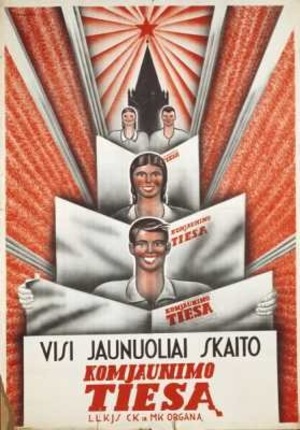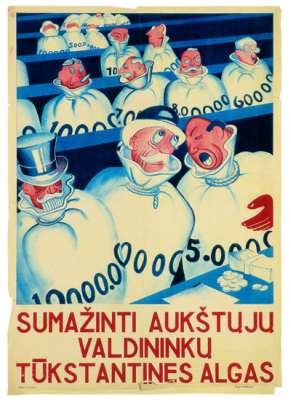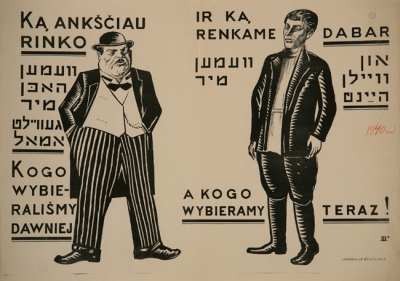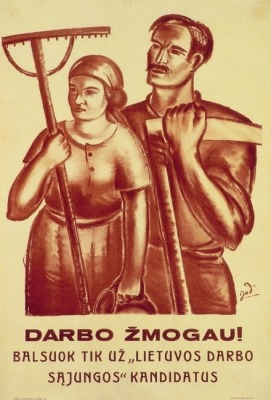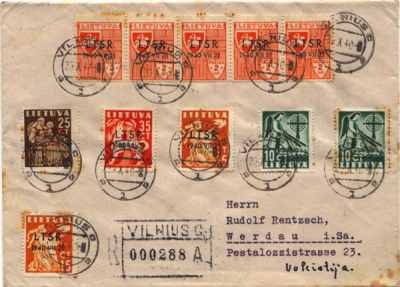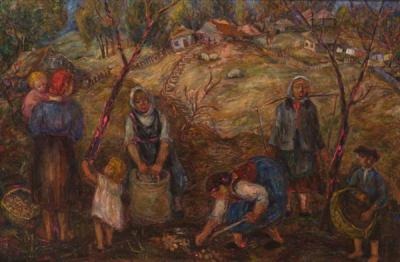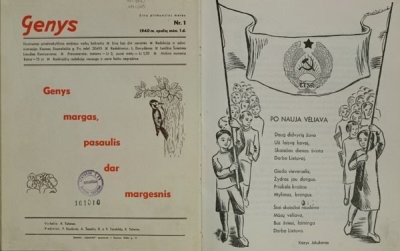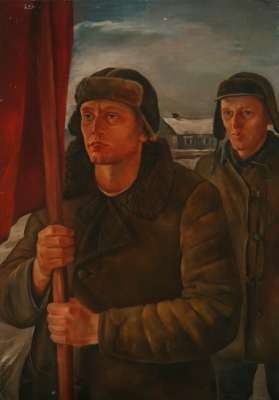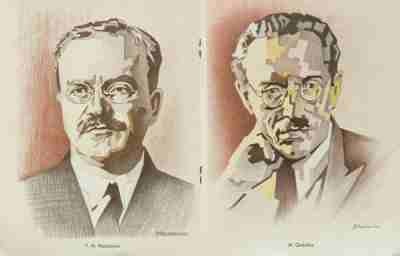LITHUANIAN ART IN 1940-1941: RED BAND ON CREATORS’ EYES 0
Rasa Andriušytė
www.kamane.lt, 2010 06 30
In the exhibition "Under the Red Star"
Poster by S.Ušinskas
In brief: The exhibition “Under the Red Star” is open at Kaunas Historical Presidential Palace: voices of Justas Paleckis, Salomėja Nėris echo from a film, Stalin and Lenin smile from portraits. All this may be viewed ironically and slightly leniently from the perspective of present independence and freedom; still, unpleasant truth whiffs to the face: serving to the politics and ideological demagogy of some artists as well as red agitation is part of history of Lithuanian culture of 1940-1941. It has not been evaluated yet, it is not completely clear; therefore, it needs research and diagnosis.
The curator of the exhibition Giedrė Jankevičiūtė carried out socio-cultural research and reconstructed art history of one year in great detail. No exhibitions revealing the role of artists in periods of political turns have been organised in Lithuania yet. The exhibition “Under the Red Star” is part of the bigger scientific project of G.Jankevičiūtė “Lithuanian Art Life in 1939-1944” dedicated to several political and cultural turns.
The exhibition “Under the Red Star” encompasses the period of one year chronologically: from June of 1940, when Lithuania “joined” the USSR (Union of Soviet Socialist Republics) to the summer of 1941, when the Nazi occupation replaced the Soviet occupation. The exhibits and filmed material tells about a stage of naïve expectations of all people living in Lithuania and, first of all, of art and science intelligentsia, the commitment of some artists to communistic ideology, about inability to analyse and judge about the political evil after surrendering to the illusion of personal welfare and recognition.
The montage of film frames prepared by the curator and architect of the exhibition Julija Reklaitė reflects how the state of Lithuania was ruined in the short period of two months. After the Soviet Army stepped into Kaunas on the 15th of June of 1940, the red bad fell on the eyes of the free nation. The “request” of Lithuania to become a member of the USSR was satisfied on the 3rd of August, and the Constitution of the Lithuanian SSR was ratified on the 24th of August. All the events took place only a few steps from the Presidential Palace in Kaunas, in the State Theatre (present Musical Theatre).
Anonymous author. Electioneering poster (in Lithuanian, Jewish and Polish) “Who was elected earlier and who is elected by us now”. 1940, Lithuanian Academy of Sciences, Vrublevskiai Library.
The exhibits of the exposition and the selected texts from the press of that time reveal the real confusion of minds and emotions caused by total sovietisation.
Antanas Gudaitis. Poster “Labouring man! Vote only for candidates of the Lithuanian Labour Union”. 1940, Lithuanian National Museum.
Vytautas Kasiulis. Advertisement poster of the newspaper Komjaunimo Tiesa (Truth of the Communist Union of Youth). 1941, Lithuanian National Museum.
Works created by artists in independent Lithuania were sometimes used for posters and illustrations of newspapers. They confused the viewer and created an impression that nothing changed much. Also, the history of postage stamps reflect the situation of Lithuania, which altered in one year, well.
Use of censored postage stamps. Envelope with Soviet stamps of summer of 1940 from Vygintas Bubnys' collection.
Artists started receiving national orders in autumn of 1940. Antanas Gudaitis started painting “Four Communards”, Justinas Vienožinskis – “Meeting of Peasants”, Povilas Puzinas – “Distribution of Land to Peasants”. Strange themes and requirement of realism appeared to be hard tasks to Lithuanian artists; therefore, it is hard to speak about artistry of their works.
Marija Cvirkienė. "Digging of Potatoes". 1940, Lithuanian Art Museum.
Naturalistic and at the same time surrealistic portraits of Lenin and Stalin painted by Vilnius artist of Karaite origin Bari Egiz are showcased in the exhibition. The faces are painted accurately, while the clothes seem to hand strangely as if there was no body underneath. The portraits of B. Egiz are most probably the only works in the exhibition that correspond to the dogmas of socialistic realism. Canvases of Leonardas Kazokas, Marija Cvirkienė, Vladas Jankauskas on the theme of work reflect the continued earlier tradition of painting. There are not many works from the period of 1940-1941 in museum funds. According to the exhibition curator, the most expressive examples of socialistic realism were destroyed by hands of authors themselves as soon as the noise of German motorbikes was heard in Kaunas streets.
Pages from the press make an important part of the exhibition. Texts of those times spread official propaganda news written by instructed people. The war-like and optimistic tone of the Soviet press set in 1940 remained the same until the times of Perestroika.
Also, Soviet propagandists allocated much attention to books and magazines. Books of Soviet authors were issued one after another in autumn of 1940. Translations from Russian were published in huge numbers of copies: Michail Zoshchenka “Stories about Lenin” (10 thousand copies, two issues), G. A. Tichomirov “Molotov” (25 thousand copies). Soon the “imported” literature was replenished by the red publications written and designed by Lithuanians.
Cover of the magazine “Genys”, No. 1, 1941 with illustrations on the theme of Lenin by Domicelė Tarabildienė.
Turn-up page of the magazine “Genys”, No. 1, 1940 with illustration by Domicelė Tarabildienė for the poem of Kazys Jakubėnas “Under the New Flag”.
Children received serious attention of the Soviet authorities. The first monthly magazine “Genys” (“Woodpecker”) was issued from the autumn of 1940. One may marvel the skill of the author to see ideological signs in nature. Visitors of the exhibition may go through pages of copies of the first issues of the magazine. Texts about the Red Army, for instance, were also published unobtrusively in the issues of the magazine of 1940-1941.
Cover of the magazine “Genys”, No. 6 (the last), 1941 with illustrations of Jonas Juozas Burba. It is probable that it is the last work created by the artist in Lithuania before deportation.
The last hall of the Historical Presidential Palace may appear slightly empty; still, the emptiness functions as the tragic scenography of deportation, death and non-existence. The lives of Sofija Romerienė, Vytautas Bičiūnas, Adomas Smetona, Jonas Juozas Burba, Juozapas Perkovskis were violated by the system. Nobody knows why – they made a contribution to Soviet authorities by their art; however, but they experienced the fate of many the most active and clever people of the country who endangered the new regimen.
Sofija Romerienė, "To the Election", 1941, National M. K. Čiurlionis Art Museum.
The exhibition will not receive unanimous evaluations. The experience of several generations and their relation with the communistic ideology enforced upon Lithuania in the year 1940 and the machine of compulsion that gathered momentum later is different of every generation.
The author of the article supports the thought read in the weekly Šiaurės Atėnai once that “it may be believed that artists believed naively at the period of changes of 1940 that the annexation of Lithuania to the empire controlled by Stalin's dictatorship would improve lives of people.” Intellectuals hoped to preserve at least the cultural sovereignty and believed that political changes would not have any impact on artists. They wanted recognition and material remuneration hoping that the generous Soviet authorities would evaluate their attempts. However, wasn’t the naivety of the intelligentsia too dangerous?
Balys Macutkevičius. Coloured insert in the magazine “Genys” with portraits of Viacheslav Molotov and Mečislovas Gedvilas.
Show-bill with the repertoire of Vilnius Drama Theatre: “Ironside 14–69”, “Hope”, “Young Gardeners”, “Topaz”, 1941, Lithuanian Academy of Sciences, Vrublevskiai Library.
Photograph from the performance “Ironside 14-69”. Filonov – Valys Derkintis. Lithuanian Theatre, Music and Cinema Museum.
Photograph from the performance “Ironside 14-69”. Old Lady from the roof of the Orthodox church – Ona Juodytė. Lithuanian Theatre, Music and Cinema Museum.
Photograph from the performance “Ironside 14-69”. Scene on ant the roof of the Orthodox church: Sin Bin U – Valys Derkintis, Vaska Okorok – Petras Zulonas, Vershinin – Mečys Chadaravičius. Lithuanian Theatre, Music and Cinema Museum.
Photograph from the performance “Ironside 14-69”. At the armed train gun (with papacha Vershinin – Mečys Chadaravičius). Lithuanian Theatre, Music and Cinema Museum.








